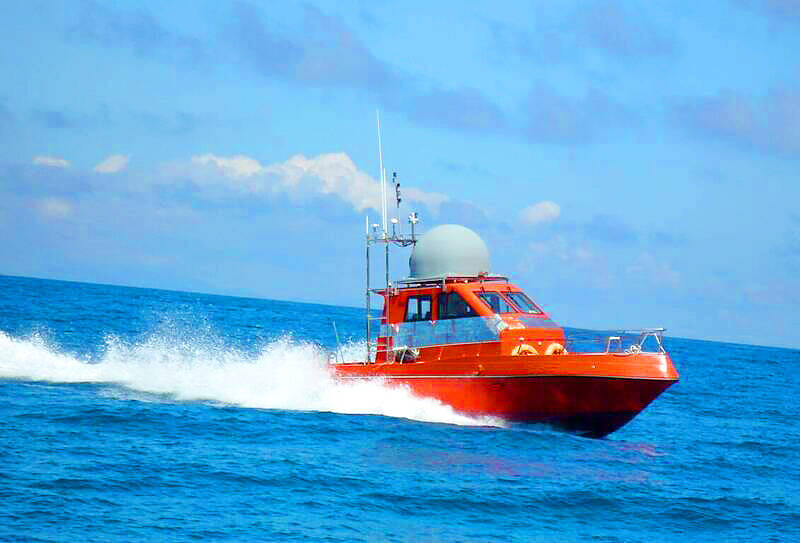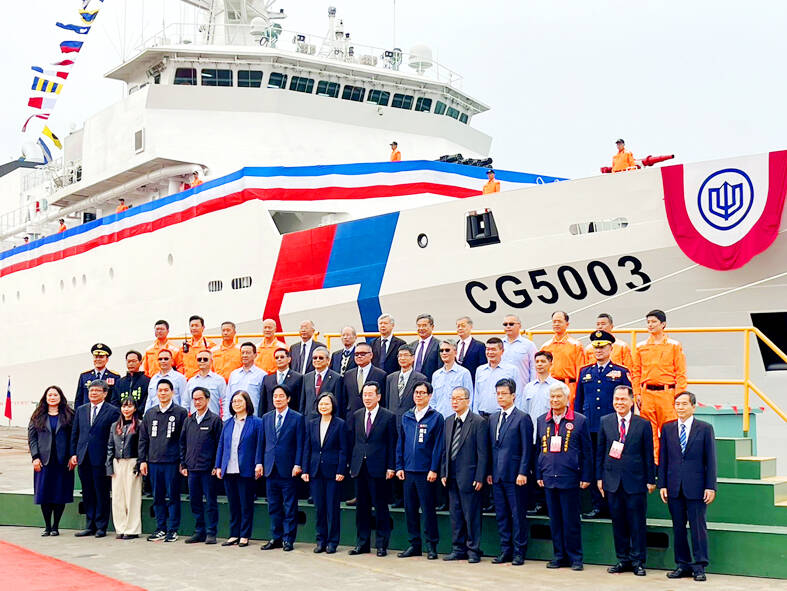The army is considering buying 200 armed sea drones after the Chungshan Institute of Science and Technology begins mass production in 2026, a source said yesterday.
The institute has said that it is developing armed target drones with sonar, radar and weapon modules, which would serve as multipurpose uncrewed boats that can perform coastal defense missions, strikes, and detect submarines and mines.
The army and navy have expressed interest in the uncrewed boat program, with the former estimating that it could use 200 of the vessels, a defense official familiar with the matter said, speaking on condition of anonymity.

Photo: Screen grab from the institute’s Web site
The army believes that armed sea drones could effectively counter or deter Chinese People’s Liberation Army Navy warships and landing craft near Taiwan, the official said.
Meanwhile, the navy believes it could use the drones to carry out raids against Chinese navy ships, they said, adding that the limited range of the autonomous watercraft could be improved by releasing them from larger naval vessels.
Sea drones, mainly those loaded with explosives to strike targets, are utilized extensively by the Ukrainian armed forces against Russians, with one reportedly sinking the Sergey Kotov on Sunday last week.

Photo: CNA
Meanwhile, President Tsai Ing-wen (蔡英文) and Vice President William Lai (賴清德), the president-elect, attended a ceremony marking the respective delivery and christening of the Coast Guard Administration’s 4,000-tonne Chiayi-class offshore patrol vessels Yunlin and Taipei.
The event was held at CSBC Corp, Taiwan’s (台灣國際造船) shipyard in Kaohsiung.
Local media interpreted the presence of Tsai and Lai at the ceremony as a move to boost morale among coast guard officers amid political furor revolving around the capsizing last month of a Chinese boat attempting to evade the coast guard off Kinmen County. Two Chinese fishers died in the incident.
Tsai refrained from commenting on the incident and did not take questions from reporters, but said in her address that the coast guard has Taiwan’s thanks for “standing steadfast at their post and defending the nation’s sovereign waters.”
The construction of the patrol vessels — which have boosted the nation’s indigenous shipbuilding sector, economy and the coast guard’s capabilities — is part of the nation’s indigenous shipbuilding program, she said.
The domestic manufacturing of warships and patrol vessels is key to conveying Taiwan’s commitment to safeguarding freedom and democracy to the world, she added.
The Yunlin and Taipei are respectively the third and fourth ship of their class, a cutter-type vessel that displaces 5,000 tonnes when fully equipped with 70mm rockets, 20mm guns, water cannons, a helipad and a field hospital.
The government has set aside NT$42.6 billion (US$1.4 billion) for an initiative to boost the local shipbuilding industry and beef up Taiwan’s maritime patrol capacity.
According to the Ocean Affairs Council, 141 coast guard ships are to be built by 2027 under the initiative, which began in 2018.
Additional reporting by CNA

The US government has signed defense cooperation agreements with Japan and the Philippines to boost the deterrence capabilities of countries in the first island chain, a report by the National Security Bureau (NSB) showed. The main countries on the first island chain include the two nations and Taiwan. The bureau is to present the report at a meeting of the legislature’s Foreign Affairs and National Defense Committee tomorrow. The US military has deployed Typhon missile systems to Japan’s Yamaguchi Prefecture and Zambales province in the Philippines during their joint military exercises. It has also installed NMESIS anti-ship systems in Japan’s Okinawa

‘WIN-WIN’: The Philippines, and central and eastern European countries are important potential drone cooperation partners, Minister of Foreign Affairs Lin Chia-lung said Minister of Foreign Affairs Lin Chia-lung (林佳龍) in an interview published yesterday confirmed that there are joint ventures between Taiwan and Poland in the drone industry. Lin made the remark in an exclusive interview with the Chinese-language Liberty Times (the Taipei Times’ sister paper). The government-backed Taiwan Excellence Drone International Business Opportunities Alliance and the Polish Chamber of Unmanned Systems on Wednesday last week signed a memorandum of understanding in Poland to develop a “non-China” supply chain for drones and work together on key technologies. Asked if Taiwan prioritized Poland among central and eastern European countries in drone collaboration, Lin

NO CONFIDENCE MOTION? The premier said that being toppled by the legislature for defending the Constitution would be a democratic badge of honor for him Premier Cho Jung-tai (卓榮泰) yesterday announced that the Cabinet would not countersign the amendments to the local revenue-sharing law passed by the Legislative Yuan last month. Cho said the decision not to countersign the amendments to the Act Governing the Allocation of Government Revenues and Expenditures (財政收支劃分法) was made in accordance with the Constitution. “The decision aims to safeguard our Constitution,” he said. The Constitution stipulates the president shall, in accordance with law, promulgate laws and issue mandates with the countersignature of the head of the Executive Yuan, or with the countersignatures of both the head of the Executive Yuan and ministers or

CABINET APPROVAL: People seeking assisted reproduction must be assessed to determine whether they would be adequate parents, the planned changes say Proposed amendments to the Assisted Reproduction Act (人工生殖法) advanced yesterday by the Executive Yuan would grant married lesbian couples and single women access to legal assisted reproductive services. The proposed revisions are “based on the fundamental principle of respecting women’s reproductive autonomy,” Cabinet spokesperson Michelle Lee (李慧芝) quoted Vice Premier Cheng Li-chiun (鄭麗君), who presided over a Cabinet meeting earlier yesterday, as saying at the briefing. The draft amendment would be submitted to the legislature for review. The Ministry of Health and Welfare, which proposed the amendments, said that experts on children’s rights, gender equality, law and medicine attended cross-disciplinary meetings, adding that